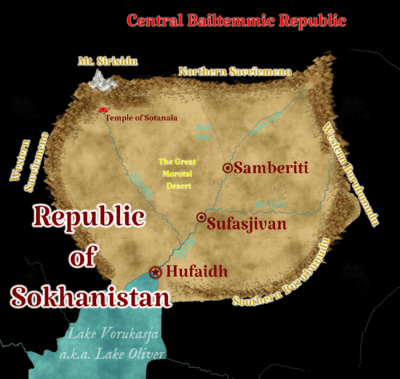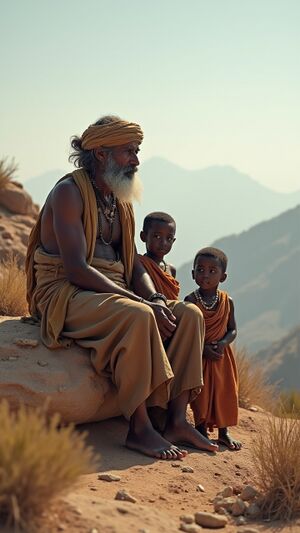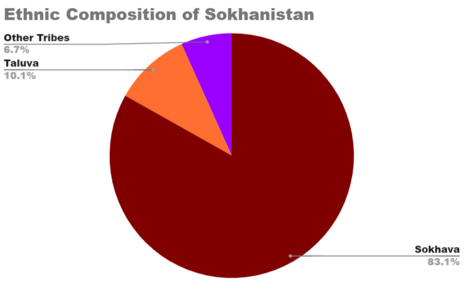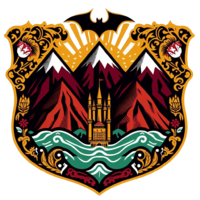Sokhanistan (Pacifica): Difference between revisions
No edit summary |
|||
| Line 48: | Line 48: | ||
[[File:Sufasjivan.jpg|thumb|433x433px|Sufasjivan]] | [[File:Sufasjivan.jpg|thumb|433x433px|Sufasjivan]] | ||
Sufasjivan was built with intentionality, mirroring the architectural ingenuity first seen in Hufaidh. To avoid disturbing the rivers, the settlers constructed an extensive network of stilted walkways and raised gardens, creating an interwoven structure that allowed the waters to flow freely beneath. Homes, communal kitchens, and meditation halls floated like lotus leaves on the surface of the river, connected by bridges adorned with symbols of the Sokhainean and Taluan beliefs. The settlement also featured canals to draw river water into community wells, along with systems of cisterns and basins to catch rainwater, reflecting the settlers' commitment to self-sufficiency and environmental harmony. | Sufasjivan was built with intentionality, mirroring the architectural ingenuity first seen in Hufaidh. To avoid disturbing the rivers, the settlers constructed an extensive network of stilted walkways and raised gardens, creating an interwoven structure that allowed the waters to flow freely beneath. Homes, communal kitchens, and meditation halls floated like lotus leaves on the surface of the river, connected by bridges adorned with symbols of the Sokhainean and Taluan beliefs. The settlement also featured canals to draw river water into community wells, along with systems of cisterns and basins to catch rainwater, reflecting the settlers' commitment to self-sufficiency and environmental harmony. | ||
[[File:Hufaidh.jpg|thumb|427x427px|Hufaidh, Capital of Sokhanistan]] | |||
==== Modern Age ==== | ==== Modern Age ==== | ||
| Line 62: | Line 63: | ||
To survive this arid climate, vegetation in the lowlands has adapted to drought conditions, with hardy shrubs, acacia trees, and resilient grasses dominating the landscape. The people of Hufaidh and Ponaiga have developed '''water conservation techniques''' such as rainwater harvesting and cisterns, allowing them to make the most of the limited seasonal rainfall. | To survive this arid climate, vegetation in the lowlands has adapted to drought conditions, with hardy shrubs, acacia trees, and resilient grasses dominating the landscape. The people of Hufaidh and Ponaiga have developed '''water conservation techniques''' such as rainwater harvesting and cisterns, allowing them to make the most of the limited seasonal rainfall. | ||
===== Seasonal Variations and Trade Influences ===== | ===== Seasonal Variations and Trade Influences ===== | ||
Revision as of 14:04, 12 November 2024
Sokhanistan is a small, mountainous, and landlocked country located in the heart of central Bailtem. Known for its stunning landscapes, the country is characterized by towering peaks, deep valleys, semi-arid flat terrain, and slow-flowing rivers. Despite its modest size, with an area of approximately 125.438 km², Sokhanistan's semi-arid terrain, complicated politics, and isolated geopolitical situation make it somewhat of a hermit kingdom.
The country is bordered by wilderness, enhancing its isolated charm. Sokhanistan includes the island of Ponaiga, and its tallest peak is Mt. Sirisidu. The Sjuhu River, which flows through much of the central part of the country, is nourished by tributaries originating from the four majestic mountains along its border: Sirisidu, Kalamaru, Samonisu, and Seitanoñ.
Republic of Sokhanistan Jomhuri-ye Sokhanistan (Sokhainean) ಸೋಖನಿಸ್ತಾನದ ಗಣರಾಜ್ಯ (Taluma) | |
|---|---|
Motto: "..." "" "..." | |
Anthem: "May I grow my garden here" | |
| Location Of Sokhanistan. Territories of Sokhanistan . | |
 | |
| Capital and largest city | Hufaidh 2°25'N 25°69'E |
| Official languages | Sokhainean Talu |
| Ethnic groups | Sokhava Taluva |
| Religion | Dorosjadin |
| Demonym(s) | Sokhanistani |
| Legislature | Sjoroma |
| Pesjigulo | |
| Fomanulo | |
| Establishment | |
• Unification | 22 March 1688 |
| Area | |
• Total | 125.438 km2 (48.432 sq mi) |
| Population | |
• Estimate | 4.286 million |
• Density | 34.18/km2 (88.5/sq mi) |
| GDP (nominal) | estimate |
• Total | 9.65 billion |
• Per capita | 2.252 |
| Currency | Lulu (SKL) |
| Time zone | UTC |
| Date format | dd/mm/yyyy CE - AE |
| Driving side | left |
| Calling code | +278 |
| World Forum Code | SO |
| Internet TLD | .so |
Etymology
The name "Sokhanistan" derives from a combination of elements from the Sokhainean language, reflecting the country’s cultural and linguistic heritage. Here's a breakdown of its etymology:
- Sokhan: The root word Sakha in Old Sokhainean translates to "divine" or "holy."
- -stan: The suffix -stan comes from Sokhainean, meaning "land" or "place of."
Thus, Sokhanistan can be interpreted as "The Holy Land", "Land of the Holy People", or "The Place of Divinity," emphasizing both the sacred nature of the land and the significant spiritual heritage of the people who inhabit it. This name underscores the reverence for divine communication and the centrality of the sacred in the Sokhanistan identity.
History
Prehistory
In Sokhanistan, evidence suggests that humans arrived around 10,000 BCE, bringing with them a resilient hunter-gatherer lifestyle well-suited to the rugged terrain and geographic isolation. Petroglyphs etched into cave walls across the region attest to the thriving culture of these early communities, whose artistic expressions hint at rich spiritual and social lives. These semi-nomadic people likely moved seasonally along mountain paths, following animal migrations and foraging opportunities, adapting to the rhythm of Sokhanistan’s diverse ecosystems.
Around 2,000 BCE, the first permanent settlements began to take root, marking a shift from the mobile hunter-gatherer lifestyle to a more sedentary, agriculturally driven society. Archaeologists hypothesize that these early settlers are the ancestors of the modern Taluva people. This transition may have been motivated by environmental changes, innovations in crop cultivation, or the development of trade networks that allowed for a more settled existence. The Taluan culture, with its distinct linguistic and cultural traditions, likely evolved from these ancient communities, drawing on both the legacy of their nomadic past and the stability of settled life.

The Taluan Guthus
The Taluan society, from its early clan-based structure, was deeply rooted in a system where each settlement - or guthu - was organized around powerful clan leaders known as Guththuga. These chieftains held dual authority—both as political leaders and spiritual figures. The Guththuga were responsible not only for the governance and protection of their respective territories but also for overseeing religious ceremonies, festivals, and rites that strengthened the social and spiritual fabric of the Taluan community. Their leadership was essential in uniting the people, organizing labor for communal projects, and maintaining harmony among clans.
The Guththuga-led society was thriving, with each settlement operating semi-autonomously under its chieftain’s guidance. Taluan settlements maintained intricate social networks, trading, marrying across clans, and establishing shared cultural practices. However, these early connections among clans and settlements proved to be a double-edged sword.
In the 14th and 15th centuries, a series of devastating epidemics swept through the region, transmitted through both established trade routes and seasonal migrations. These epidemics—likely introduced by external contacts or intensified by ecological pressures—overwhelmed Taluan society. The densely interconnected clan structure that had once strengthened the Taluan community now amplified the spread of illness, causing mass casualties and weakening the social structure. Hundreds of thousands were lost, including many Guththuga, which destabilized the clan hierarchy and left many communities leaderless and vulnerable.
One Taluan city that remained relatively intact was Samberiti, which is the oldest and third largest city in Sokhanistan.
This crisis prompted a cultural shift within Taluan society, with survivors seeking new methods to manage and protect their communities. Some settlements consolidated, pooling resources and knowledge to withstand future threats, while others turned to medicinal practices and rituals to fortify spiritual resilience. Out of necessity, the role of the Guththuga evolved, with remaining chieftains adapting to an increased focus on healing, protective rites, and the well-being of their people, shaping Taluan society for generations to come.
The Arrival of the Sokhava
The founding of Hufaidh in the early 18th century marks a pivotal moment in Taluan history, illustrating the emergence of an unlikely alliance and a blending of cultural ideologies that would shape the future of the region. This event began when Mazataka, a fervent advocate for pacifism, egalitarianism, and freedom, broke away from the warlike and expansionist Kustannuksan Empire. Uniting people from diverse religious and philosophical backgrounds—including Bharaists, Mesopoists, Jaïaists, Hebraists, Atheists, Christians, Muslims, and Buddhists—Mazataka sought to create a peaceful community that lived in harmony with the land and each other. However, the Christians and most of the Muslims were eventually banished due to them proselytizing to the other groups.
After a long, challenging journey south, Mazataka and his followers, who called themselves the Sokhava ("Holy People"), were invited by Guthu Soamavini to settle on a swath of sacred land. However, upon arrival, Soamavini, seemingly gripped by a sudden apprehension or change of heart, forbade any building on the hallowed ground, warning that any disturbance of the earth could anger the spirits of the ancestors and disrupt the spiritual balance of the land.
Determined but respectful of the Taluan customs, Mazataka and his followers devised an ingenious solution that would honor the sacred land while establishing their community: they constructed a stilted settlement at the river’s mouth, a design that elevated their homes and communal spaces above the land without breaking its surface. The community used local bamboo, palm wood, and reeds, creating light but resilient structures that allowed the river to flow freely and kept the land beneath untouched.
The ingenuity and cultural sensitivity shown by the Sokhava impressed Guthu Soamavini, who saw in Mazataka's community a reflection of his people’s values, even if expressed in new ways. The Sokhava’s philosophy of harmony, pacifism, and their refusal to harm or alter the land resonated with Soamavini's own reverence for ancestral grounds. Gradually, the Taluva, initially cautious and observant, began visiting Hufaidh more frequently, drawn by the Sokhava’s peaceful and thriving way of life. Over time, they began to cohabitate, bringing with them Taluan customs, crafts, and stories, which blended with the Sokhava’s communal lifestyle.
The fusion of Sokhava’s ideals of egalitarianism and pacifism with the Taluva’s reverence for the land and their ancestral rituals led to a unique society. Hufaidh soon became known as a place of sanctuary and cooperation—a hub where cultural and spiritual practices coalesced to create a harmonious, pluralistic society. Taluva and Sokhava artisans collaborated on crafts, festivals combined elements from each culture, and the settlement adopted practices from both heritages, such as vegetarianism, communal decision-making, and spiritual meditations focused on natural elements like the river and the surrounding forests.
Expansion

The success of Hufaidh not only solidified the bond between the Sokhava and the Taluva but also paved the way for the community’s expansion and the deepening of their shared ideals. Inspired by the unique coexistence in Hufaidh, a neighboring Guthu, moved by the peaceful prosperity he witnessed, offered the island of Ponaiga as a gift to the Sokhava in 1753. This act demonstrated a significant shift in the Guthus' attitude toward the Sokhava, recognizing their genuine respect for Taluan values and their commitment to protecting the sacredness of the land. The Sokhava received the island with humility, and in honor of the Guthu's generosity, they vowed to maintain Ponaiga as a sanctuary, preserving its natural beauty and cultivating it as a haven for meditation, learning, and spiritual practice.
Meanwhile, in 1756, a coalition of Sokhava and Taluva settlers set their sights on a new frontier: the confluence of the five major rivers that formed the Sjuhu watershed. This place, where water flowed from all corners of the region into a single, mighty river, held symbolic power for both cultures. For the Taluva, it represented unity and the gathering of ancestral energies; for the Sokhava, it symbolized the interconnectedness of all life. Here, they established the settlement of Sufasjivan—a name combining elements from both Sokhava and Taluan dialects, loosely translating to "Place of Good Union"

Sufasjivan was built with intentionality, mirroring the architectural ingenuity first seen in Hufaidh. To avoid disturbing the rivers, the settlers constructed an extensive network of stilted walkways and raised gardens, creating an interwoven structure that allowed the waters to flow freely beneath. Homes, communal kitchens, and meditation halls floated like lotus leaves on the surface of the river, connected by bridges adorned with symbols of the Sokhainean and Taluan beliefs. The settlement also featured canals to draw river water into community wells, along with systems of cisterns and basins to catch rainwater, reflecting the settlers' commitment to self-sufficiency and environmental harmony.

Modern Age
Geography
Climate
The region surrounding Hufaidh, Ponaiga, and Sufasjivan spans a diverse range of climates due to its variation in elevation, proximity to Lake Vorukasja (also known as Lake Oliver), and differences in seasonal precipitation.
Lowland Climate: Semi-Arid Region around Lake Vorukasja
The lowland semi-arid region where Hufaidh and Ponaiga are situated has a dry, subtropical climate. Summers are long, hot, and dry, with temperatures regularly reaching 35–40°C (95–104°F), particularly in the months of late spring and early summer. Winters are mild and short, averaging around 10–15°C (50–59°F), with occasional cold fronts bringing cooler nights.
Lake Vorukasja moderates the immediate coastal climate, adding a touch of humidity to the air near the lake, especially in the morning and evening, when mists sometimes form. Annual rainfall is low, typically between 250–400 mm (10–16 inches), with most precipitation occurring during the short rainy season, usually in late winter or early spring. During this period, sporadic but intense storms provide crucial water, filling rivers and streams that flow down toward the lake. These storms, though infrequent, are essential for replenishing the water resources that sustain the region's agriculture and settlements.
To survive this arid climate, vegetation in the lowlands has adapted to drought conditions, with hardy shrubs, acacia trees, and resilient grasses dominating the landscape. The people of Hufaidh and Ponaiga have developed water conservation techniques such as rainwater harvesting and cisterns, allowing them to make the most of the limited seasonal rainfall.
Seasonal Variations and Trade Influences
The stark difference between the lowland semi-arid and upland cloud forest climates creates a natural complementarity that fuels trade between the regions. While the lowlands are suited for growing drought-resistant grains and fruits, the cloud forests yield valuable medicinal plants and timber. The seasonal rains in the lowlands bring brief fertility, allowing Hufaidh and Ponaiga to cultivate during this time, while the year-round rainfall in Sufasjivan supports more constant production of diverse forest goods.
Flora and Fauna
Mountains & Rivers
Island of Ponaiga
Politics
Government
Sokhanistan’s government is based on the principles of communalism and religious teachings, drawing inspiration from the core values of Wakwakism, a faith that emphasizes life, balance, and the stewardship of time and nature. The governance system incorporates both collective decision-making and spiritual guidance, mirroring elements of the Mazdakite revolution, which influenced the structure of its political system.
Structure and Leadership
Sokhanistan is led by Gohul representatives, collectively known as the Gohulu, who govern according to the principles of joy, discernment, comprehension, and preservation. These four Gohul representatives are elected through a complex process that involves both community input and spiritual guidance. The Gohulu are responsible for managing the nation's legislative, executive, and judicial functions, ensuring that governance aligns with the values of Wakwakism and Sokhanistan’s communal traditions.
Each Gohul is responsible for a specific aspect of governance:
- Gohul Rameši (Joy): Responsible for the happiness and well-being of the population, ensuring that societal policies foster a sense of joy and communal prosperity.
- Gohul Mobadi (Discernment): Oversees matters related to wisdom, knowledge, and spiritual guidance, ensuring that policies are aligned with the principles of Dorosjadinism.
- Gohul Herebi (Comprehension): Manages the nation's understanding of external affairs and policies, focusing on education and diplomacy.
- Gohul Sebabi (Preservation): Ensures the protection of Sokhanistan’s resources, cultural heritage, and spiritual practices, preserving the nation’s history and natural environment.
These four leaders are chosen in different ways, with Gohul Rameši and Gohul Mobadi being appointed by a council of spiritual elders, while Gohul Herebi and Gohul Sebabi are elected by the communal-republics.
Ombudsmen
Dodovulo (Joy): Comprised of 13 Dodovo ("Ombudsmen") nominated by Gohul Rameši and Gohul Herebi. These representatives travel across the nation, gathering data and ensuring policies reflect the happiness and well-being of the people. They serve as arbiters in policy discussions, offering suggestions on improving the quality of life.
Legislative Branch
The legislative branch of Sokhanistan is composed of the Sjoroma, a council divided into two chambers:
- Fomanulo (Comprehension): Composed of 219 Fomano ("Lower House Representatives") democratically elected by the Communal-Republics. These members draft and create policies, often working in political parties that represent the diverse cultural and spiritual interests of the people. They focus on policy areas, such as education, economics, and governance.
- Pesjigulo (Preservation): Comprised of 75 Pesjigo ("Upper House Representatives") who are non-democratically elected. These representatives represent the heads of important non-profit organizations, syndicates, religious institutions, trade guilds, and worker unions. Their role is to ensure the preservation of Sokhanistan’s resources, cultural heritage, and the principles of Dorosjadin in the nation’s governance. The Pesjigulo focuses on ensuring the sustainability of the nation’s social and economic systems, and that the needs of Sokhanistan’s labor force and communal organizations are considered in policy development.
The Sjoroma is designed to balance the interests of the people with the spiritual and communal values of Sokhanistan. Legislation must be approved by both chambers and ratified by the Gohulu before becoming law.
Judicial Branch
The judicial system of Sokhanistan is based on principles of restorative justice, truth-seeking, and reconciliation. The highest judicial authority is the Khamatan Court, which handles constitutional matters, disputes, and significant legal cases. It is composed of respected legal scholars, spiritual leaders, and community elders, who interpret laws based on a combination of traditional wisdom and modern legal standards.
Below the Khamatan Court, local courts exist within each province to handle day-to-day legal matters. These courts ensure that Sokhanistan’s justice system maintains fairness and harmony while upholding the communal and spiritual values of the nation. Restorative justice practices are prioritized, with a focus on reconciliation over punitive measures.
Religion and Governance
Dorosjadin, the dominant religion of Sokhanistan, has a profound influence on its political system. The nation’s spiritual leader, the Matji, provides guidance on religious matters and helps ensure that governance aligns with the teachings of Dorosjadin. The Matji works closely with the Gohulu and the Sjoroma, offering counsel on decisions that affect both the spiritual and practical aspects of life in Sokhanistan.
While the Vajnatana does not hold direct political power, their spiritual influence is felt across all aspects of governance, from the legislative process to the execution of policy. The Vajnatana also serves as the primary figure in rituals, ceremonies, and public events, symbolizing the connection between Sokhanistan’s governance and its divine principles.
Provinces and Autonomy
Sokhanistan is divided into several provinces, each governed by its own local Gohul representative. These provinces operate with a high degree of autonomy, managing their own affairs and ensuring that local governance remains rooted in communal values. The provinces are responsible for implementing national policies at the local level, but they must align with the broader goals set by the Gohulu.
Each province is also encouraged to maintain its cultural heritage, with local customs and spiritual practices being respected and integrated into governance. However, all provinces must adhere to the overarching principles of Sokhanistan, particularly the values of balance, peace, and ecological stewardship.
Political Parties
Sokhanistan has a multi-party system that reflects its diverse communities and the importance of consensus in governance. Political parties are generally organized around cultural, spiritual, and regional lines, with each party working to ensure that their community’s interests are represented in the Sjoroma. However, the political system is designed to prioritize collective welfare over individual power, with no party or faction able to dominate the decision-making process.
Campaigns are heavily regulated to ensure that they focus on the well-being of the people, the preservation of Sokhanistan’s values, and the sustainable development of the nation. Political debates and negotiations are often centered on achieving consensus and fostering unity.
Foreign Relations
Sokhanistan’s foreign policy is guided by its commitment to peace, sustainability, and respect for all life. The nation seeks to engage with other countries that share its values of ecological responsibility, social justice, and spiritual harmony. Sokhanistan advocates for global cooperation on environmental issues, human rights, and the protection of cultural diversity.
Religion and Governance
Provinces and Autonomy
Military
Economy
Agriculture and Natural Resources
Agriculture remains a central part of Sokhanistan's economy, especially in the lowland regions near Lake Vorukasja and the fertile valleys along the Sjuhu River. Despite its semi-arid climate and limited rainfall, Sokhanistan has developed resilient agricultural practices, prioritizing drought-resistant grains, legumes, fruits, and medicinal herbs. Sustainable techniques such as agroforestry, permaculture, and terracing help conserve soil and water in the uplands, where erosion is a concern. Sokhanistan’s limited forests are mainly scrub and shrublands adapted to the arid climate, and natural resources include abundant freshwater from river systems, essential for supporting agriculture and local communities. Ethnobotanical practices, focusing on hardy native plants with medicinal uses, play a notable role in both local healthcare and the economy, with exports of medicinal herbs contributing modestly to national revenue.
Tourism
Tourism in Sokhanistan is founded on eco-tourism, cultural immersion, and sustainability principles that attract environmentally conscious visitors. Popular destinations include the shores of Lake Vorukasja, the historical city of Hufaidh, and the arid mountain landscapes around Sufasjivan. Sensitive areas limit visitor numbers to preserve fragile ecosystems, and all tour operators must adhere to eco-friendly guidelines. Tourists are invited to experience traditional crafts, herbal medicine, and Sokhanistan's unique vegetarian cuisine, often staying in community-run lodges or eco-resorts that reinvest profits into local development. Cultural workshops, festivals, and guided nature treks allow tourists to immerse themselves in Sokhanistan’s heritage and environmental values, reinforcing its reputation as a sustainable travel destination.
Energy
Sokhanistan’s commitment to renewable energy helps it overcome the constraints of its semi-arid environment. Solar power, abundant in the sunny lowlands, and wind energy from highland regions make up most of the country’s energy production. The Sjuhu River provides limited hydroelectric power, with micro-hydro and solar projects bringing electricity to rural communities, while larger urban centers rely on solar farms and wind turbines. National energy policies emphasize minimizing environmental impacts, and community education programs promote energy conservation, aligning with Sokhanistan’s commitment to sustainability.
Manufacturing
Manufacturing in Sokhanistan is small-scale and centered on artisanal goods, textiles, and ethnobotanical products derived from drought-resistant plants. The Sokhava and Taluva communities are skilled in weaving, pottery, woodworking, and jewelry-making, producing items sold locally and exported. The manufacturing sector is decentralized, organized as cooperatives and community-owned enterprises rather than large factories, with eco-industrial parks in urban areas integrating green technologies. Regulations ensure minimal pollution and fair wages, supporting sustainability and community well-being.
Jewelry
An essential economic activity in Sokhanistan is the production of fresh-water pearl jewelry. With limited forest resources, Sokhanistan has focused on utilizing its water systems sustainably. Freshwater pearls, cultivated in Lake Vorukasja and sections of the Sjuhu River, are crafted into high-quality jewelry that appeals to local and international markets. Pearl farming provides an eco-friendly, culturally valuable income source, supporting artisans and aligning with Sokhanistan’s environmental goals. These pearls are showcased in eco-tourism shops and cultural events, strengthening Sokhanistan's identity as a sustainable, artisan-focused economy.
Infrastructure
Sokhanistan’s infrastructure reflects its commitment to low-impact, sustainable development. The transportation network includes well-maintained roads connecting key cities and towns, with electric buses and bike lanes widely available in urban areas. Farajastan, the capital, has an extensive pedestrian zone and green roofs on many public buildings. In rural areas, footpaths and electric tuk-tuks serve as primary means of transport. Railways link major urban centers, and the country’s emphasis on renewable energy is evident in its solar-powered street lighting and water infrastructure. High-speed internet access is also widely available, with an emphasis on digital infrastructure that supports educational and healthcare needs in even the most remote regions.
Public Policy
Public policy in Sokhanistan is driven by values of environmental sustainability, social equality, and communal decision-making. The government actively promotes vegetarianism, environmental protection, and pacifism, with national policies that reflect these principles. Sokhanistan has comprehensive laws for the conservation of forests and waterways, as well as policies supporting sustainable agriculture and eco-tourism. Public health and education are universal and funded through community-based taxation. Public policy is shaped by a combination of traditional Guththuga councils and elected officials, creating a blend of modern governance and cultural heritage.
Science and Technology
Science and technology in Sokhanistan focus on environmental sustainability, agricultural innovation, and healthcare. Research centers, particularly in Sufasjivan, study fields like ethnobotany, renewable energy, and climate resilience. Sokhanistan has developed an international reputation for advancements in permaculture, organic agriculture, and water conservation technologies. Digital technology is used to support environmental monitoring and public services, with many government services available online to reduce bureaucracy. Traditional knowledge is also highly valued, with collaborative programs between scientists and local experts to preserve and utilize indigenous agricultural and medical practices.
Demographics

In Sokhanistan, ethnic composition is dominated by the Sokhava, who make up over 80% of the population. Known for their rich cultural heritage, the Sokhava form the foundation of Sokhanistani identity and are primarily concentrated in the lowland areas, where they have historically developed the nation’s cultural, economic, and spiritual centers.
Approximately 10% of the population are the Taluva, the indigenous people of Sokhanistan. The Taluva have deep ancestral ties to the land and often reside in the more remote regions, particularly around traditional sites such as the Taluan holy grounds near the Temple of Sotanaïa. Known for their deep reverence for nature and their unique spiritual practices, the Taluva play a respected role in preserving Sokhanistan’s ancient customs and environmental sanctity.
The remaining population consists of immigrants and the mountain tribes, smaller communities who bring diverse backgrounds to Sokhanistan. These groups often inhabit the rugged mountainous areas where their unique ways of life and adaptation to the challenging terrain have contributed to Sokhanistan’s cultural mosaic.
Urban Areas
Template:Largest cities of Sokhanistan
Education
Sokhanistan’s education system is designed to foster critical thinking, communal responsibility, and environmental awareness. From primary through secondary levels, education is free and focuses on developing a balanced understanding of Sokhanistani history, language, mathematics, arts, and science, with a strong emphasis on practical skills and sustainable living. The curriculum includes teachings from the Desinato and community-based learning projects, promoting virtues such as joy, discernment, and preservation. Higher education is encouraged, and students may pursue specialized fields at community colleges and national universities, with state-funded scholarships available to support those from all backgrounds. Sokhanistanis highly value life-long learning, and educational centers across the country offer continuing education and vocational programs for adults to further develop skills and enrich community life.
Health
Health in Sokhanistan is treated as a public right, with a healthcare system that provides free, universal access to both preventative and curative care. The system focuses heavily on community clinics and holistic wellness practices that incorporate traditional Sokhanistani remedies alongside modern medicine, emphasizing natural treatments, mental well-being, and healthy lifestyle choices. Public health campaigns stress preventative measures, from nutrition education and exercise programs to regular wellness checkups, fostering a proactive approach to health. Sokhanistan is particularly committed to environmental health, with policies aiming to reduce pollution and protect biodiversity, reflecting a belief that public health is interconnected with the health of the natural world.
Immigration
Sokhanistan’s immigration policy is shaped by a balance between its commitment to communal well-being and its respect for diverse cultural contributions. Immigration is welcomed under a controlled integration model, where newcomers undergo cultural orientation sessions to understand Sokhanistani values, the Desinato teachings, and the Sokhainean language. Permanent residency is offered selectively, prioritizing applicants who contribute skills in education, healthcare, ecological research, and sustainable agriculture. Immigrants are encouraged to participate in community councils and, after several years of residency, can apply for naturalization, a process marked by a public affirmation of Sokhanistani values. This approach allows Sokhanistan to embrace diversity while maintaining the shared values central to its society.
Famous Sokhanis
Culture
Languages
The languages of Sokhainean and Talu are co-official in Sokhanistan.
Religion
In Sokhanistan, the dominant religion, Dorosjadin or Doroshanism, shapes the core of the nation’s cultural and ethical framework. Rooted in native traditions and philosophies, Doroshanism emphasizes harmony, respect for natural cycles, and a deep connection to the spiritual essence within all life forms. Unlike many major religions, Doroshanism discourages proselytizing; instead, it promotes introspection and personal spiritual growth.
Since Sokhanistan’s founding, Christianity, Islam, and other proselytizing religions have been prohibited. This policy is rooted in the state’s commitment to cultural autonomy and religious preservation, allowing Doroshanism’s tenets to remain central to both the public and private lives of Sokhanistani citizens. Bharaism, Jaïaism, and Hebraism are permitted alongside the dominant Doroshanism. These religions, known for their introspective and non-proselytizing nature, align well with Sokhanistan’s emphasis on cultural respect and spiritual autonomy. The coexistence of these traditions with Doroshanism indicates a cultural openness within defined boundaries, where philosophies that emphasize personal growth and internal reflection are valued and encouraged.
Each of these permitted religions brings unique philosophical and ethical dimensions to Sokhanistani society:
- Bharaism emphasizes the interconnectedness of all beings, resonating with Doroshan values of natural harmony and unity.
- Jaïaism (or Jainism) adds a focus on non-violence and self-discipline, which complements Sokhanistan’s principles of personal responsibility and respect for life.
- Hebraism (interpreted perhaps through a cultural, non-proselytizing lens) contributes ethical and ritual traditions that align with Sokhanistani values of community, wisdom, and preservation of heritage.
Value System and Society
Value System and Society in Sokhanistan centers around a communalist philosophy that emphasizes unity, respect for nature, and social equity. Rooted in principles derived from ancient Sokhava beliefs and inspired by teachings in the holy text, the Desinato, Sokhanistani society fosters shared responsibility and cooperation among its people. The Desinato underscores four primary virtues: Joy (Rameši), Discernment (Mobadi), Comprehension (Herebi), and Preservation (Sebabi), which guide societal roles, governance, and interpersonal relationships.
In daily life, Sokhanistanis prioritize communal well-being over individual gain, with resources managed collectively to ensure equal access to education, healthcare, and public services. Social programs and locally organized councils empower citizens to actively contribute to and shape their communities, creating a collaborative spirit across the country. Environmental stewardship is deeply embedded in the value system; respect for the natural world is taught from an early age, and citizens are encouraged to participate in eco-friendly practices, from sustainable agriculture to wildlife preservation efforts.
Respect for diversity is another cornerstone of Sokhanistani values, promoting equality across gender, ethnicity, and cultural heritage. These principles extend into a formalized justice system that focuses on reconciliation, rehabilitation, and conflict resolution, prioritizing personal and community growth over punitive measures. As a result, Sokhanistan's society is marked by a strong sense of collective purpose, where personal success is often viewed through the lens of one’s contribution to the greater good.
Public Holidays
Nua Rodja
- Date: March 20 or 21 (Spring Equinox)
- Theme: New Beginnings and Renewal
- Description: Nua Rodja marks the Sokhainean New Year and the arrival of spring. Families gather for festive meals, set up decorative arrangements with symbolic items representing growth, renewal, and hope, and perform rituals to welcome a prosperous new year. It’s a time for reconnecting with loved ones and giving thanks for life’s blessings.
Satonaïagan
- Date: July 1 (Mid-Summer)
- Theme: Water, Agriculture, and Renewal
- Description: Satonaïagan honors Satonaïa, the goddess of rain, water, and agriculture, celebrating the life-giving power of water. The holiday includes water-based activities like splashing and sprinkling, symbolizing renewal and fertility. People gather near rivers and lakes, offer prayers for rain and abundant harvests, and enjoy traditional water-based sweets and fruits, underscoring the significance of water in sustaining both crops and communities.
Divali
- Date: Late October/Early November
- Theme: Honesty, Harmony and the Triumph of Goodness.
- Description: Diwali, the Festival of Lights, celebrates the triumph of light over darkness and goodness over evil, with homes and streets adorned in vibrant lanterns and candles. Families come together to enjoy festive meals, share gifts, and express gratitude, creating a harmonious atmosphere filled with joy and renewal.
Day of Remembrance
- Date: December 26 (Winter)
- Theme: Reflection, Ancestors
- Description: This solemn holiday is dedicated to honoring ancestors and reflecting on past generations' wisdom. People visit family shrines, leave offerings, and light candles in memory of their loved ones. It’s a time for introspection, renewal of family bonds, and making resolutions for personal growth in the coming year. This day also emphasizes the importance of connecting with heritage and ancestral teachings.
Djasjan-i Sodi
- Date: 50 days before Nua Rodja (around late January or early February)
- Theme: Fire, Warmth, and Resilience
- Description: This festival commemorates the discovery of fire and symbolizes the triumph of warmth over winter’s cold. It’s celebrated with bonfires, which people gather around as a symbol of protection, light, and community. Djasjan-i Sodi also marks the start of the Carnival Season in Sokhainean culture, a period of vibrant celebrations, music, and dance leading up to Holi.
Holi
Date: Early March
Theme: Unity, Renewal, and the Celebration of Life
Description: Holi, the Festival of Colors, welcomes the arrival of spring and celebrates the joy of life and renewal. Friends and family gather to playfully throw vibrant, plant-based powders, sharing laughter, music, and festive treats, as they strengthen bonds, forgive past grievances, and embrace new beginnings in a joyful, colorful atmosphere. Holi also marks the end of Carnival Season with a major colourful parade.
Literature
Arts, Architecture, and Design
Architecture in Sokhanistan is deeply functional and ecologically integrated, blending traditional craftsmanship with modern communalist values. Buildings in urban areas prioritize harmony with natural elements and emphasize sustainable materials such as clay, wood, and limestone. Structures often feature intricate facades with carvings of native wildlife and nature-inspired symbols, emphasizing Sokhanistan’s deep reverence for the natural world. Additionally, skylights, open courtyards, and green rooftops are common in both residential and public buildings, enhancing ventilation, natural light, and greenery.
Design in Sokhanistan spans textiles, ceramics, and furniture, often reflecting motifs inspired by Sokhainean mythology and folklore. Sokhanistani textile designs are celebrated for their intricate embroidery and patterns, particularly in ceremonial garments, where traditional plant-based dyes create colors representing different aspects of Sokhanistani culture. Furniture and household items are crafted using local materials with a minimalistic, functional aesthetic that reflects Sokhanistan’s communalist principles and resource-conscious approach. Across arts, architecture, and design, the Sokhanistani aesthetic emphasizes interconnectedness, tradition, and sustainability, resonating with its communal values and cultural heritage.

Temples
The Temple of Sotanaïa is a marvel of Sokhanistani engineering, situated majestically at the base of Mt. Sirisidu, the tallest peak in Sokhanistan. Nestled between the towering mountain and a sacred Taluan holy site, this Agiary Temple is dedicated to Sotanaïa, the Sokhainean goddess of water revered throughout Sokhanistan. Legend tells of the lake beside the temple, said to possess healing properties imbued by the goddess herself.
Built with precision and artistry, the temple merges stone, tile, and intricately wrought metalwork, with designs that reflect the flow and life-giving qualities of water. The temple’s interior is serene and filled with soft, natural light; reflecting pools and a central altar create a space for pilgrims to make offerings and seek the goddess’s blessings. Healing rituals often take place along the lake’s shore, and visitors journey here from far and wide, drawn by the mountain’s majestic presence and the promise of Sotanaïa’s blessings.
The towering Mt. Sirisidu frames the temple as a guardian, adding to the spiritual significance of the site. For the Sokhanistani, the mountain and lake form a divine pairing, symbolizing the balance between strength and sustenance. This sacred setting has made the Temple of Sotanaïa a cornerstone of Sokhanistani spiritual life—a place where worship, community, and nature converge, grounded in the timeless reverence for water and the enduring power of the natural world.
Airport
Givara International Airport is the sole airport in Sokhanistan, due to the country’s rugged, mountainous terrain that makes constructing additional airfields nearly impossible. Located on the island of Ponaiga, this airport is a critical point of entry for visitors and residents alike. From Givara International, travelers can take scenic ferry rides across the straits to Hufaidh, Sokhanistan’s primary city, which lies inland and is inaccessible by air.
SokhAir, Sokhanistan’s national airline, operates all flights into and out of Givara International, providing connections to select international and regional destinations. This unique geographic setup adds to Sokhanistan’s allure, as visitors often enjoy the picturesque ferry journey from Ponaiga to the mainland, where they are greeted by the dramatic peaks and valleys that characterize the Sokhanistani landscape.

